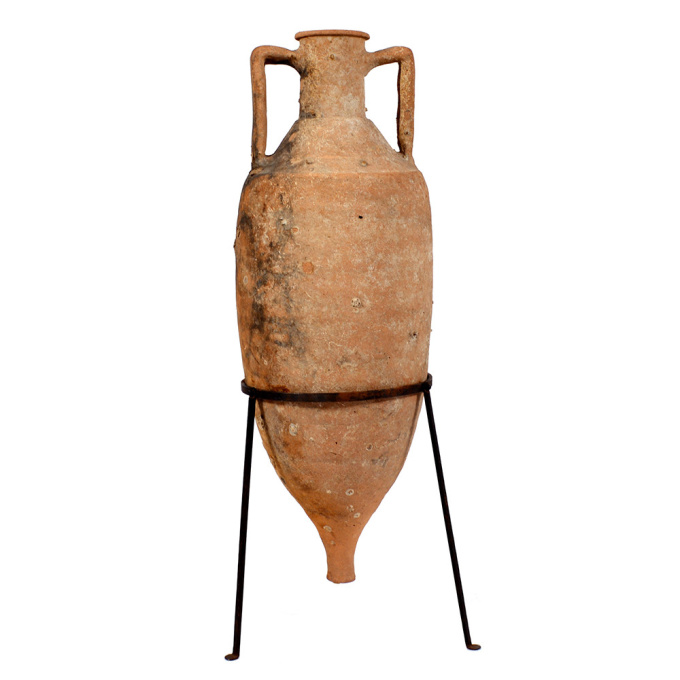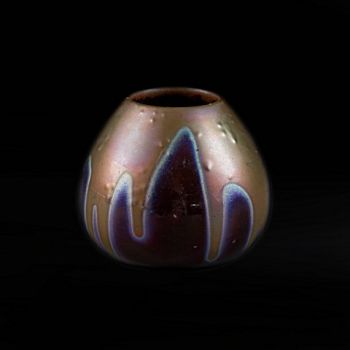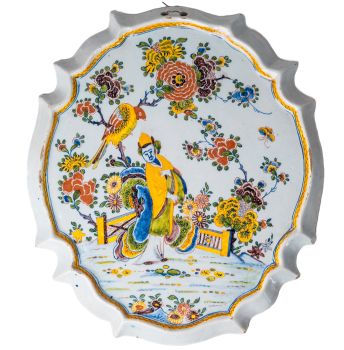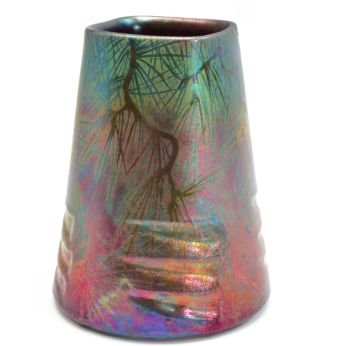Borboleta de ouro do final do período vitoriano com strass vermelho e meias pérolas 100 BC - 100 AD
Artista Desconhecido
TerracotaCerâmica
91 cm
Atualmente indisponível via Gallerease
- Sobre arte
This amphora type was based on prototypes from the Aegean island of Cos (Koan type). It has a simple ring-like rim with circular section, and a straight neck ending in a marked shoulder. With a cylindrical body and a solid cylindrical spike. The handles, which comprise two parallel clay shafts with a characteristic bifid section, are flexed and join the amphora immediately below the rim and on the shoulder close to its junction with the neck. With some marine encrustation to one side from long-term underwater exposure, while the other side was most likely submerged in sand and therefore protected. The amphora is fully intact and offered including stand. 91 cm (h) Type: Dressel 2-4 Italian; Koan amphora; Peacock & Williams 10 Ex German private family collection, owned since the 1950s The precise origin of domestic viticulture and winemaking in Rome has not been determined. Early Roman culture was sharply influenced by the ancient Greeks, which makes it likely that the Mycenaean Greeks had some influences in the Roman wine culture through early settlements in southern Italy. Because the ancient Greeks saw wine as a staple of domestic life and a viable economic trade commodity, their settlements were encouraged to plant vineyards for local use and trade. Southern Italy’s abundance of indigenous vines provided an ideal opportunity for wine production Wine had religious, medicinal and social roles that set it apart from other Roman cuisine. Wine, like in Greek culture was mixed with water, and both cultures held banquets, where wine was used to show off wealth and prestige. As Rome entered its golden age of winemaking and the era of expansion, a “democratic” approach to wine started to emerge. Wine was increasingly viewed as a necessity of everyday life rather than simply a luxury enjoyed by the elite. It became available to slaves, peasants and aristocrats, men and women alike. The widespread planting of grapes ensued from the need to serve all classes of society, but was also given impetus by the changing Roman diet. In the 2nd century BC, Romans began to shift from meals consisting of moist porridge and gruel to those more bread-based; wine aided in eating the drier food.
- Sobre artista
Pode acontecer que um artista ou criador seja desconhecido.
Algumas obras não devem ser determinadas por quem são feitas ou são feitas por (um grupo de) artesãos. Exemplos são estátuas dos tempos antigos, móveis, espelhos ou assinaturas que não são claras ou legíveis, mas também algumas obras não são assinadas.
Além disso, você pode encontrar a seguinte descrição:
•"Atribuído a …." Na opinião deles, provavelmente uma obra do artista, pelo menos em parte
• “Estúdio de…” ou “Oficina de” Em sua opinião um trabalho executado no estúdio ou oficina do artista, possivelmente sob sua supervisão
• "Círculo de ..." Na opinião deles, uma obra da época do artista mostrando sua influência, intimamente associada ao artista, mas não necessariamente seu aluno
•“Estilo de…” ou “Seguidor de…” Na opinião deles, um trabalho executado no estilo do artista, mas não necessariamente por um aluno; pode ser contemporâneo ou quase contemporâneo
• "Maneira de ..." Na opinião deles, uma obra no estilo do artista, mas de data posterior
•"Depois …." Na opinião deles uma cópia (de qualquer data) de uma obra do artista
• “Assinado…”, “Datado…” ou “Inscrito” Na opinião deles, a obra foi assinada/datada/inscrita pelo artista. A adição de um ponto de interrogação indica um elemento de dúvida
• "Com assinatura ….”, “Com data ….”, “Com inscrição ….” ou “Tem assinatura/data/inscrição” na opinião deles a assinatura/data/inscrição foi adicionada por outra pessoa que não o artista
Related artworks
- 1 - 4 / 12
Artista Desconhecido
The bell of the VOC fortress in Jaffna, Sri Lanka1747
Preço em pedidoZebregs & Röell - Fine Art - Antiques
 Com curadoria de
Com curadoria deDanny Bree
1 - 4 / 13Klaas II Mobach
Hanna Mobach, daughter of the sculptor Klaas Mobach, reading1950 - 1970
Preço em pedidoKunsthandel Pygmalion
1 - 4 / 24


















































